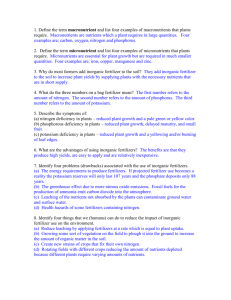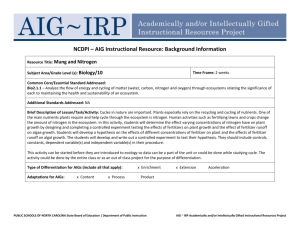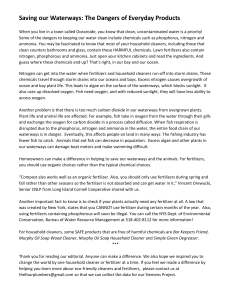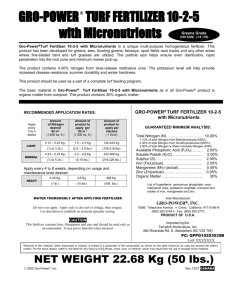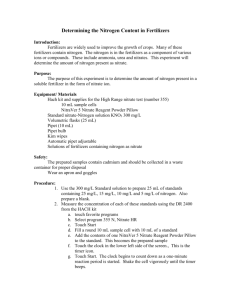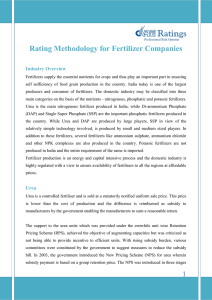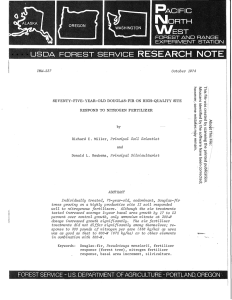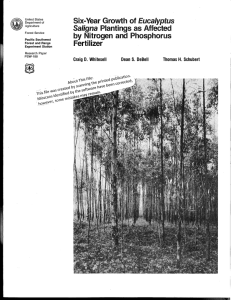Mineral_Nutrition_talk
advertisement
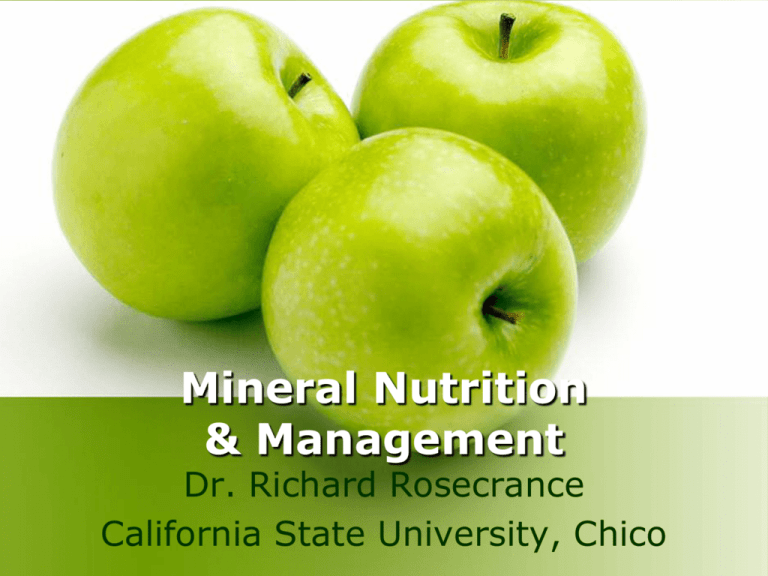
Mineral Nutrition & Management Dr. Richard Rosecrance California State University, Chico Productivity & Profitability Outline 1. 2. 3. 4. Nutrient pathways to plants N fertilization efficiency. N budgeting, a method of accounting for tree N demand & sources N fertilizer selection & timing How do nutrients get to the plant roots? 1. 2. 3. Nutrient Pathways to Roots 1. Root interception: Ca, (Zn) 2. Mass flow of water: N, Ca, Mg, S, B, (K), (Zn) 3. Diffusion: P, K, (Zn) Cation Exchange Capacity Nitrate In Groundwater Nitrogen fertilizer efficiency trend in Nebraska -1 Partial Factor Productivity (kg grain kg N ) 80 70 Even with these improvements, average N fertilizer uptake efficiency is only about 40% of applied N with average yields of about 10 Mt per hectare. A 2-fold increase is possible! 60 50 40 30 y = 0.7153x - 1372.9 R2 = 0.7081 20 1960 1965 1970 1975 1980 1985 1990 1995 2000 2005 2010 N efficiency 1. 2. 3. 4. Amount & and seasonal patterns of N use by trees N availability from nonfertilizer sources (i.e.irrigation water, cover crops) dynamics of fertilizer N availability relationships between timing, amount of fertilizer, and irrigation water applied Part 1 Concepts of Fertilization Midsummer leaf N Concentrations < 2.3% deficient 2.3 – 2.7% adequate > 2.7% excessive Terminal leaflet on spur Mid-Shoot Leaf Samples leaves Seasonal Variation in LeafWhen to sample leaves? nutrient Concentrations Using Leaf Analysis Results to Adjust Fertilizer Practices If Leaf N > above critical value, fertilizer can be reduced or eliminated for a year without impacting growth & yield (esp. on heavy-textured soils) N Use by the Tree Forms of N absorbed by the tree NH4+ NO3 N Uptake -- Greatest between onset of active shoot growth until late stages of nut fill N removal in crop Walnut -40 lbs of N/ton of crop N removal calculators http://npk.nrcs.usda.gov/ Whole Tree N Contents by Organ in Almond. 3000 H a r v e s t 2500 N contents (g) 2000 Uptake 1500 roots trunk canopy leaves fruit 1000 500 0 2/20 0 3/2 5/20 8/29 Excavation Date 9/29 Nitrogen budgeting to determine how much to apply N Losses Nitrogen budgeting to determine how much to apply N Losses Volatilization-N lost directly to atmosphere N in ammonium and urea fertilizers may be released to the atmosphere as ammonia gas. (NH4+→ NH3) pHs >7.5 ↑ volatilization. Volatilization from fertilizers can be ↓ by rapid incorporation Effect of rainfall on Urea N volatilization losses Rainfall Within days N after Volatilization application Losses, % 0.4 2 0 0.4 0.1 to 0.2 0 3 5 5 10 10 to 30 30+ (Fox and Hoffman, Pennsylvania – N on no-till corn) Denitrification 1. 2. 3. soil microorganisms: soil nitrates → N2. N loss ↑ when soils are warm and wet. Denitrification losses are typically less than 5% but can be higher under lowoxygen conditions Losses with urea Urea has no electrical charge, so it moves readily in the soil with rain or irrigation water. Volatilization losses from urea fertilizers are low if urea fertilizers are incorporated into the soil shortly after application. Nitrate Losses Nitrate fertilizers are generally more costly per unit of nitrogen than are ammonium fertilizers. Nitrate is highly mobile in the soil. Choosing & Using N Fertilizers Su Source: Ca Plant Health Association 2002 Worksheet Instructions In order to use the nitrogen budgeting approach you will need: 1. yield data for the past few years 2. irrigation records 3. irrigation water nitrate analyses 4. records of compost/manure applications 5. estimates of cover crop yield and nitrogen content 6. calculator Nitrogen Fertilizer Timing and Placement Nitrogen recovery. Fertilizer recovery is greatest when application coincides with periods of high nitrogen demand by trees Split applications. A good rule of thumb is to apply onehalf to two- thirds of the fertilizer nitrogen in spring, so it is available during the main flush of spring shoot growth. The remainder should be applied by later during nut fill Best Management Practices Successful N management delivers enough N to the crop to optimize yield and profitability while ↓ losses to water and air. Everyone wants the nitrogen to end up in the crop. Thus, the best management practices (BMPs) presented here are identified as sound practices from economic, production and environmental viewpoints.
